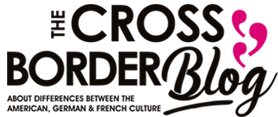
Food Coloring in America is just crazy
Christmas time means the return of bright red and green colors in American stores. Surprisingly for my French-German tastes, these festive colors also appear in food. My 40 years in Europe inform my perception of healthy food. Why is America so crazy about artificial-looking food? Are we Europeans just slower to accept it?
America is great in terms of food coloring. My children, as all young children, love bold and chintzy colors. When we arrived in the United States, grocery shopping with them was a terrible experience. They’d ask for green and red candy, electric blue Gatorade, and a colorful birthday cake whose colors defy common sense. “Honey, have you ever seen bluish fruits and pink veggies?” I’d ask them. They’d response by saying, “But I like it sooo much, and it looks so pretty. Please, Maman, can I get one for my birthday?”
My common sense told me that the colors used in the American food industry are not natural. Yes, I know there are food dyes in most processed food I’d buy at a supermarket. Without dyes, meat turns to a disgusting grayish-brownish a few days after being cut. Butter and margarine are not naturally yellow but white, and the most obviously dyed food is probably found in candies like Skittles and M&Ms.
Food coloring in America
Perhaps my judgement of food dyes is contradictory, and I guess that my views represent the general opinion in Europe. If artificial colors make food look natural, I have no problem and don’t even think about it. Meat has to be red, peas green, and tomato sauce red. Fading and changing colors in food make it look unappetizing and spoiled, and in the end, I wouldn’t buy it.
However, for yogurts, cookies, candy, and soda, I react with zero tolerance. After 40 years in Europe, I have a clear perception of healthy food. Call me a hypocrite, but I will not change my mind that fluorescent colors have no place in food.
Alexandra, a good friend of mine, was the first to point out the danger of synthetic food dyes. Her 9-year-old daughter always had a hard time focusing at school. Equally important, she was angry most of the time and wouldn’t fall asleep. For years, Alexandra looked for answers and after watching this video (English with French subtitles), she decided to cut out all food with coloring and preservatives. Three weeks later, her daughter’s behavior dramatically improved.
Why does American food have brighter colors than European food?
I think at least three reasons explain this difference.
First of all, at the end of the 19th century, large chain stores and self-service supermarkets expanded in America. This phenomenon took place later in Europe, only after WWII.
In supermarkets, where clerks were not needed anymore, purchase decisions were based on product visuals, which increased the brand competition. Because of the sheer size of the country, it became crucial to stabilize food color. By the 1930s, uniform coloration was the norm in the American food industry. Synthetic dyes had replaced natural colors and provided a standardized food color. * Source: Harvard Business School
Secondly, Europeans understand food by its nutritional content. To me, Americans seem more interested in the visual aspect of food, expressed in size and colors. As I stated at the beginning of this post, food coloring can be seen two ways. It makes food look natural and fresh like in canned food, butter, and meat products. But, it also informs brand identity (e.g. M&Ms) and helps consumers to make choices (e.g. candy and dessert brands).
Eventually, the European Union’s public health is ruled by the precautionary principle. This is not so in the US, where a proof of harm has to be provided before a regulatory action is taken.
Ultimately, Americans are used to bright colors in food, but Europeans are not. If you’ve ever gone grocery shopping with someone from Europe, you’ll know what I mean.
Why extreme food coloring has little chance of succeeding in Europe
Besides legislation, European consumers have different interests.
I wrote extensively about the German love of organic food in an article, entitled “Why are Germans the leader in organic food?” I think a strong sense of chemophobia is common in Germany.
In France and Southern Europe, farmers’ markets are widespread and loved. Purchasing fruits and vegetables means frequently having to accept imperfect shape and colors. Taste comes before visual uniformity.
The downside of food coloring in America
Alexandra’s experience is not random. In 2007, a study from the National Center for Biotechnology Information concluded that “artificial colors or a sodium benzoate preservative (or both) in the diet result in increased hyperactivity in 3-year-old and 8/9-year-old children.”
Since the 1970s, American consumers have questioned the safety of synthetic colors in food. In 2013, Buzzfeed published a list of eight ingredients banned outside of the US but used in America. Today, even in America, food coloring is more a challenge than an opportunity for food makers.
Big manufacturers get it. In 2015, General Mills, best known for its cereal brands, announced its intent to remove artificial dyes and flavors from its cereals by 2017. Last February, Mars, the global manufacturer of confectioneries and pet food, followed with plans to get rid of all artificial colors in its candies. Over the next five years, artificial colors and flavors should disappear from M&Ms, Skittles, Twix, and gum.
A final thought
Granted, food coloring is present in Europe. Even if colors don’t add flavor to food, they help my Europeans pals to imagine how it tastes. Europe just prefers other food colors than America. We look for more natural colors, albeit added through artificial dyes.





need a picture of Haribo gummies up there with the Jello!
IMO, you are right – Americans use color to have fun- but there were some colors that were allowed like red dye #? that were toxic. (we used beets:) until the government outlawed them.
this German firm discusses its abilities with color, including synthetic as both technical and legislative – that is so true!
http://www.sensient-fce.com/product.html
By the way, the American Haribo gummies use brighter colors than the German ones!
And why, I ask, are you not on an advisory council for the Montgomery County School Board? Or the U.S. Department of Education? As the video you posted on this week’s blog demonstrated, schools are in a unique position to bring parents, students, cafeteria workers and teachers together to implement prohibitions against dye, preservative and flavoring additives to food for kids. I felt sick looking at the photos of other-worldly colors of the foods, especially desserts, illustrating your article. Nothing that gross looking should be put into a person’s mouth!
If the color does not occur in natural food, don’t use it! I can be reprogrammed to accept brownish gray meat in the display case!
Thank you Margaret.
Merci Catherine!
General Mills a déjà beaucoup de céréales sans colorant, c’est chez eux que j’achète la plupart de ce que les enfants consomment (mais pas toutes les boites!). Je suis impatiente de gouter des Skittles sans colorants ni arômes artificiels, je dois en fournir un paquet pour l’école la semaine prochaine… Je ne comprends pas que les écoles n’interdisent pas ce genre de produit…